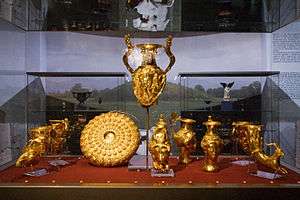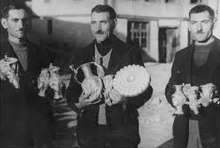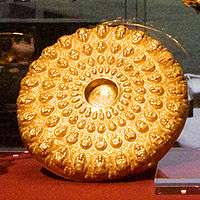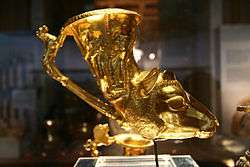Panagyurishte Treasure
The Panagyurishte Treasure (Bulgarian: Панагюрско златно съкровище) is a Thracian treasure.[1]
| Panagyurishte Treasure | |
|---|---|
 | |
| Material | gold |
| Created | 400 BC – 300 BC |
| Discovered | 1949 at Panagyurishte |
| Present location | Regional Archaeological Museum, Plovdiv |
Description
Tsontchev, Dimiter (1955), "The Gold Treasure of Panagurishte", Archaeology, 8, pp. 218–227, JSTOR 41663325 Venedikov, Ivan (1961). Panagyurskoto sukroviste. Sofia: Bulgarski Hudozhnik. von Bothmer, Dietrich (December 1962). "A Gold Libation Bowl". The Metropolitan Museum of Art Bulletin. 21 (4): 154–166. JSTOR 3257939. Kontoleon, N.M. (1962), "The Gold Treasure of Panagurischte", Balkan Studies, 3, pp. 185–200, retrieved 24 June 2018 Corbett, P.E. (1964). "Reviewed Work: Venedikov, (I.) "The Panagyurishte Gold Treasure" Sofia: "Bulgarski Houdozhnik" Publishing House, 1961, Pp. 29, 39 plates. 14 figures". The Journal of Hellenic Studies. 84: 229–231. JSTOR 627788. Strong, Donald Emrys (1966). Greek and Roman Gold and Silver Plate. London: Methuen & Co. Ltd. pp. 97, 102. Griffith, John G. (1974). "The Siege Scene on the Gold Amphora of the Panagjurischte Treasure". Journal of Hellenic Studies. 94: 38–49. JSTOR 630418. Hoddinott, Ralph F. (1975). Bulgaria in Antiquity: An Archaeological Introduction. London, Tonbridge: Ernest Benn Limited. pp. 85, 89. Moorey, P. R. S (March 1976). "Thracian Treasures". The Burlington Magazine. 118 (876): 174, 179. JSTOR 878327. Marazov, Ivan; Fol, Alexander (1977). Thrace and the Thracians. New York: St. Martin’s Press. pp. 22, 60, 66, 69, 75, 79, 81–85, 100, 111, 153. Retrieved 8 June 2018 – via Internet Archive. Venedikov, Ivan (1977). "The Archaeological Wealth of Ancient Thrace". The Metropolitan Museum of Art Bulletin. 35 (1): 39 (color plates 9–14). JSTOR 3258668. via- Met Publications Kramer, Hilton (June 10, 1977). "Glory of Thrace Shines at MET". The New York Times: 54. Retrieved 1 June 2018. "The Panagyurishte treasure, Turn of the Fourth and Third Century B.C., Archaeological Museum, Plovdiv, items 361-369". Thracian Treasures from Bulgaria: Checklist of The Special Exhibition, June 11- September 4, 1977, coordinated by Dietrich von Bothmer. New York: Metropolitan Museum of Art. 1977. Retrieved 25 June 2018 – via Digital Collections of the Metropolitan Museum of Art. Vickers, Michael (1989). "Panagyurishte, Dalboki, Lukovit and Rogozen: Questions of Metrology and Status". In Cook, B. F. (ed.). The Rogozen Treasure: Papers of the Anglo-Bulgarian Conference 12 March 1987. London: British Museum Publications. pp. 33–37. Moonan, Wendy (May 22, 1998). "ANTIQUES; Rediscovering 'Lost' Culture Of Thrace". The New York Times. Retrieved 3 June 2018. Rotroff, Susan I. (July–August 1998). "Thracian Glitter: A dazzling display of ancient art". Archaeology. 51 (4): 64–67. Retrieved 3 June 2018 – via Archaeology Archive. Marazov, Ivan; Fol, Alexander (1998). Ancient gold: The Wealth of the Thracians: Treasures from the Republic of Bulgaria. New York: Harry N. Abrams, in Association with the Trust for Museum Exhibitions, in Cooperation with the Ministry of Culture of the Republic of Bulgaria. pp. 145–148. Archibald, Zosia H. (1998). The Odrysian kingdom of Thrace: Orpheus unmasked. Oxford, New York: Clarendon and Oxford University Press. pp. 271–272, 328. Kitov, Georgi (2003). The Panagyurishte Treasure. Varna: Slavena Publishing House. Fanthrope, Lionel; Fanthorpe, Patricia (2009). Secrets of the World’s Undiscovered Treasures. Toronto, Ontario: Dundurn. p. 72. Guzzo, Pier Giovanni; Spatafora, Francesca; Vassalo, Stefano (2010). "Una phiale d'oro iscritta dall'entroterra di Himera /An inscribed golden phial from the hinterland of Himera: from Sicily to New York and back". Mélanges de l'École française de Rome - Antiquité (122–2): 451–477. doi:10.4000/mefra.303. Chary, Frederick B. (2011). The Greenwood Histories of the Modern Nations: THE HISTORY OF BULGARIA. Santa Barbara, CA; Denver, CO; Oxford, England: Greenwood, An Imprint of ABC-Clio, LLC. pp. 1, 145. Ovadiah, Asher (2014). "A New Look at the Mythological Representation of the Panagyurishte Gold Treasure, Bulgaria". Gerión. 32: 137–155. Retrieved 27 June 2018. Valeva, Julia (2015). "Chapter 14: Gold, Silver and Bronze Vessels". In Valeva, Julia; Nankov, Emil; Graninger, Denver (eds.). A Companion to Ancient Thrace. Hoboken: John Wiley & Sons. pp. 202–203. Holt, Frank Lee (2016). The Treasures of Alexander the Great: How One Man's Wealth Shaped the World. Oxford University Press. p. 47.
Gallery
Sofia - Panagyurishte Thracian Gold Treasure (Amphora).jpg National History Museum, Sofia, Bulgaria 20090405 331.JPG Sofia - Panagyurishte Thracian Gold Treasure cutout.jpg Panagyurishte gold.jpg
External links Wikimedia Commons has media related to Panagyurishte treasure.
Panagyurishte Treasure The Panagyurishte Golden TreasureEnglish The Panagyurishte Treasure at the Plovdiv Archaeological MuseumEnglish
Categories:
1949 archaeological discoveriesPanagyurishteTreasure troves in BulgariaGold objectsAncient ThraceAncient Greek metalwork
Navigation menu
Not logged in Talk Contributions Create account Log in
Article Talk
Read Edit View history
Search
Main page Contents Featured content Current events Random article Donate to Wikipedia Wikipedia store
Interaction
Help About Wikipedia Community portal Recent changes Contact page
Tools
What links here Related changes Upload file Special pages Permanent link Page information Wikidata item Cite this page
In other projects
Wikimedia Commons
Print/export
Download as PDF Printable version
Languages
Беларуская Български Deutsch Italiano ქართული Македонски Русский Українська
Edit links
This page was last edited on 15 March 2020, at 09:19 (UTC). Text is available under the Creative Commons Attribution-ShareAlike License; additional terms may apply. By using this site, you agree to the Terms of Use and Privacy Policy. Wikipedia® is a registered trademark of the Wikimedia Foundation, Inc., a non-profit organization.
Discovery

It was accidentally discovered on 8 December 1949 by three brothers, Pavel, Petko, and Michail Deikov, who worked together at the region of “Merul” tile factory near the railway station of the town of Panagyurishte, Bulgaria.[2] At the time of its discovery it was considered "the richest treasure to have been unearthed in Europe since World War II.".[3]
Exhibitions around the world and replicas
As one of the best known surviving artefacts of Thracian culture, the treasure has been displayed at various museums around the world.[4][5][6][7][8] The treasure is the centerpiece of the Thracian art collection of the Plovdiv Regional Historical Museum, the National Museum of History in Sofia, and the History Museum in Panagyurishte.[9] There are three replica sets, which are displayed in the museums in Panagyurishte, Sofia and Plovdiv, when the authentic treasure is lent for exhibitions abroad.[10]
Notes
- Crampton, R. J. (2005). A Concise History of Bulgaria (2nd ed.). Cambridge, New York, Melbourne, Madrid, Cape Town, Singapore, São Paolo: Cambridge University Press. p. 1.
- Kitov, Georgi (2003). The Panagyurishte Treasure. Varna: Slavena Publishing House. pp. 6–9.
- Hoffmann, Herbert (1957), "Book Review: Neue Denkmäler antiker Toreutik by Bedřich Svoboda, Dimiter Cončev, Monumenta Archaeologica. Acta Praehistorica et Historica Instituti Archaeologici Academiae Scientiarum Bohemoslovenicae Curante Jaroslovo Böhm Edita, Tomus IV, Pp. 172, figs. 46, pls. 32. Prague, 1956", American Journal of Archaeology, 61, Archaeological Institute of America, p. 391, doi:10.2307/500610, JSTOR 500610
- Daumas, Michèle (1978). "L'amphore de Panaguriŝté et les sept contre Thèbes". Antike Kunst. 21 (1): 23. JSTOR 41320682.
- Thracian Treasures from Bulgaria; Introduction by Lionel Casson; Essay by Ivan Venedikov; Photographs by Lee Boltin; Design by Irwin Glusker with Christian von Rosenvinge and Eloise Vega. New York: The Metropolitan Museum of Art. 1977. pp. 41–53, 61. Retrieved 23 February 2018 – via Internet Archive.
- See Thracian Treasures from Bulgaria; 12 May - 1 July, 1979, Nagoya City Museum. Tokyo: The Chunichi Shimbun, The Tokyo Shimbun. 1979. pp. 53–57.
- Eisenberg, Jerome M. (January 1998). "The Wealth of the Thracians: A Spectacular Exhibitions of Thracian Treasures Travelling America" (PDF). The International Review of Ancient Art & Archaeology - MINERVA. 9 (1): 17. Retrieved 22 June 2018.
- Kitov, Georgi (2003). The Panagyurishte Treasure. Varna: Slavena Publishing House. pp. 46–47.
- McGloin, Cashel (March 2017), "The Panagyurishte Treasure" (PDF), Colorado Archaeological Society - Denver Chapter, 55 (3), retrieved 27 June 2018
- Ince, Kit. "Top 10 Things To Do In Sofia + Tourist's Survival Guide". 10Brutes. 10Brutes. Retrieved 13 August 2019.
Selected bibliography
- Tsontchev, Dimiter (1955), "The Gold Treasure of Panagurishte", Archaeology, 8, Archaeological Institute of America, pp. 218–227, JSTOR 41663325
- Venedikov, Ivan (1961). Panagyurskoto sukroviste. Sofia: Bulgarski Hudozhnik.
- von Bothmer, Dietrich (December 1962). "A Gold Libation Bowl". The Metropolitan Museum of Art Bulletin. 21 (4): 154–166. doi:10.2307/3257939. JSTOR 3257939.
- Kontoleon, N.M. (1962), "The Gold Treasure of Panagurischte", Balkan Studies, 3, pp. 185–200, retrieved 24 June 2018
- Corbett, P.E. (1964). "Reviewed Work: Venedikov, (I.) "The Panagyurishte Gold Treasure" Sofia: "Bulgarski Houdozhnik" Publishing House, 1961, Pp. 29, 39 plates. 14 figures". The Journal of Hellenic Studies. 84: 229–231. doi:10.2307/627788. JSTOR 627788.
- Strong, Donald Emrys (1966). Greek and Roman Gold and Silver Plate. London: Methuen & Co. Ltd. pp. 97, 102.
- Griffith, John G. (1974). "The Siege Scene on the Gold Amphora of the Panagjurischte Treasure". Journal of Hellenic Studies. 94: 38–49. doi:10.2307/630418. JSTOR 630418.
- Hoddinott, Ralph F. (1975). Bulgaria in Antiquity: An Archaeological Introduction. London, Tonbridge: Ernest Benn Limited. pp. 85, 89.
- Moorey, P. R. S (March 1976). "Thracian Treasures". The Burlington Magazine. 118 (876): 179–174. JSTOR 878327.
- Marazov, Ivan; Fol, Alexander (1977). Thrace and the Thracians. New York: St. Martin’s Press. pp. 22, 60, 66, 69, 75, 79, 81–85, 100, 111, 153. Retrieved 8 June 2018 – via Internet Archive.
- Venedikov, Ivan (1977). "The Archaeological Wealth of Ancient Thrace". The Metropolitan Museum of Art Bulletin. 35 (1): 39 (color plates 9–14). doi:10.2307/3258668. JSTOR 3258668. via- Met Publications
- Kramer, Hilton (June 10, 1977). "Glory of Thrace Shines at MET". The New York Times: 54. Retrieved 1 June 2018.
- "The Panagyurishte treasure, Turn of the Fourth and Third Century B.C., Archaeological Museum, Plovdiv, items 361-369". Thracian Treasures from Bulgaria: Checklist of The Special Exhibition, June 11- September 4, 1977, coordinated by Dietrich von Bothmer. New York: Metropolitan Museum of Art. 1977. Retrieved 25 June 2018 – via Digital Collections of the Metropolitan Museum of Art.
- Vickers, Michael (1989). "Panagyurishte, Dalboki, Lukovit and Rogozen: Questions of Metrology and Status". In Cook, B. F. (ed.). The Rogozen Treasure: Papers of the Anglo-Bulgarian Conference 12 March 1987. London: British Museum Publications. pp. 33–37.
- Moonan, Wendy (May 22, 1998). "ANTIQUES; Rediscovering 'Lost' Culture Of Thrace". The New York Times. Retrieved 3 June 2018.
- Rotroff, Susan I. (July–August 1998). "Thracian Glitter: A dazzling display of ancient art". Archaeology. 51 (4): 64–67. Retrieved 3 June 2018 – via Archaeology Archive.
- Marazov, Ivan; Fol, Alexander (1998). Ancient gold: The Wealth of the Thracians: Treasures from the Republic of Bulgaria. New York: Harry N. Abrams, in Association with the Trust for Museum Exhibitions, in Cooperation with the Ministry of Culture of the Republic of Bulgaria. pp. 145–148.
- Archibald, Zosia H. (1998). The Odrysian kingdom of Thrace: Orpheus unmasked. Oxford, New York: Clarendon and Oxford University Press. pp. 271–272, 328.
- Kitov, Georgi (2003). The Panagyurishte Treasure. Varna: Slavena Publishing House.
- Fanthrope, Lionel; Fanthorpe, Patricia (2009). Secrets of the World's Undiscovered Treasures. Toronto, Ontario: Dundurn. p. 72.
- Guzzo, Pier Giovanni; Spatafora, Francesca; Vassalo, Stefano (2010). "Una phiale d'oro iscritta dall'entroterra di Himera /An inscribed golden phial from the hinterland of Himera: from Sicily to New York and back". Mélanges de l'École française de Rome - Antiquité (122–2): 451–477. doi:10.4000/mefra.303.
- Chary, Frederick B. (2011). The Greenwood Histories of the Modern Nations: THE HISTORY OF BULGARIA. Santa Barbara, CA; Denver, CO; Oxford, England: Greenwood, An Imprint of ABC-Clio, LLC. pp. 1, 145.
- Ovadiah, Asher (2014). "A New Look at the Mythological Representation of the Panagyurishte Gold Treasure, Bulgaria". Gerión. 32: 137–155. Retrieved 27 June 2018.
- Valeva, Julia (2015). "Chapter 14: Gold, Silver and Bronze Vessels". In Valeva, Julia; Nankov, Emil; Graninger, Denver (eds.). A Companion to Ancient Thrace. Hoboken: John Wiley & Sons. pp. 202–203.
- Holt, Frank Lee (2016). The Treasures of Alexander the Great: How One Man's Wealth Shaped the World. Oxford University Press. p. 47.
Gallery
External links
| Wikimedia Commons has media related to Panagyurishte treasure. |
.jpg)

